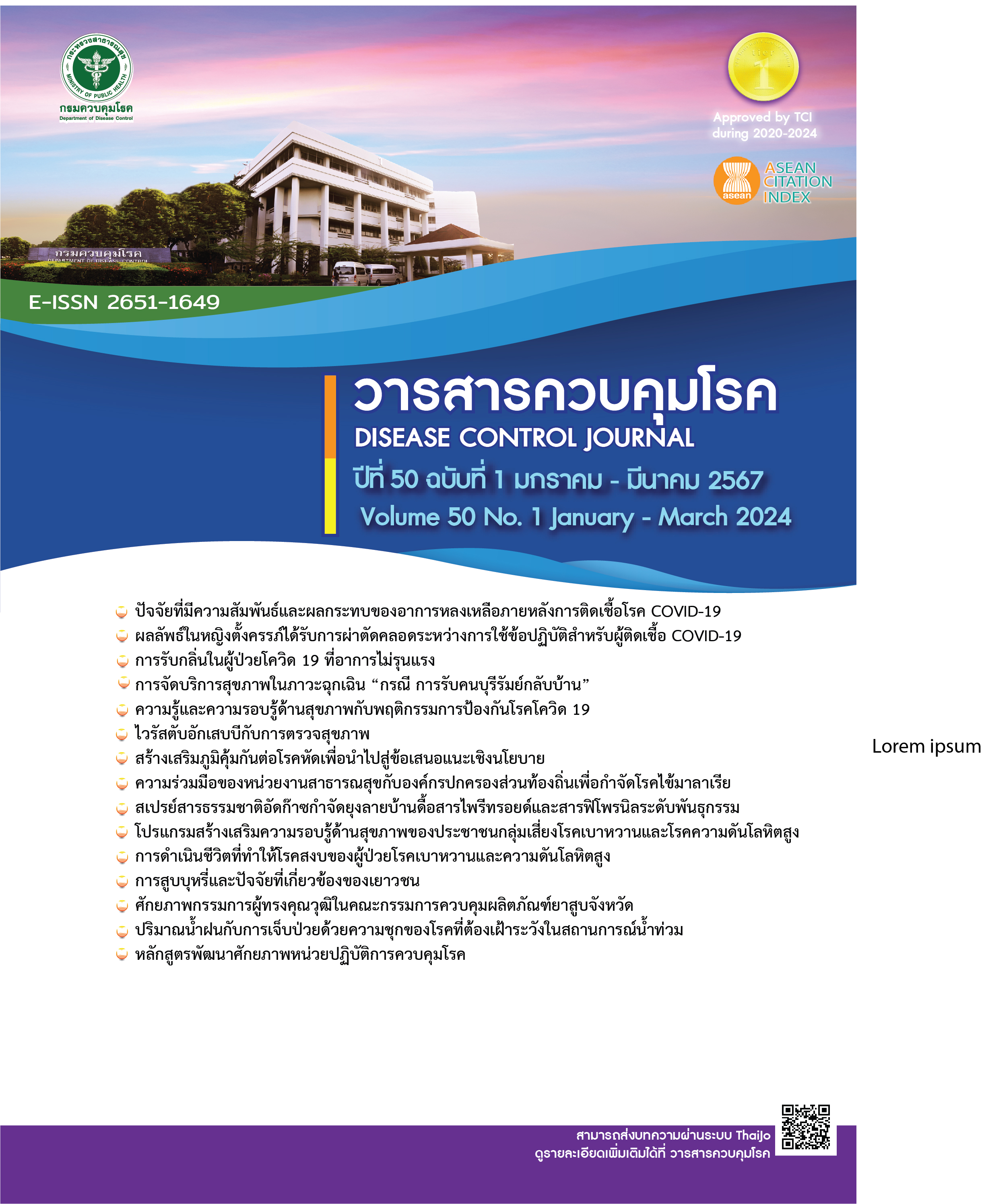Model development for providing emergency health services: The case of take Buriram people back home in the Coronavirus Disease 2019 epidemic, Buriram Province, Thailand
DOI:
https://doi.org/10.14456/dcj.2024.4Keywords:
model development, take people home, BuriramAbstract
This action research aimed at developing a model for providing emergency health services in the Coronavirus Disease 2019 epidemic called “take Buriram people back home”, Buriram Province, Thailand. The project consisted of 4 phases. The first phase encompassed a situational review and analysis. The second phase involved model planning and development. The third phase applied the model to pilot and extended areas. The fourth phase, evaluation, concludes emergency health service prototypes in emergency situations. The population in the study consisted of 1) the working group committee for model development, 2) service recipients, and 3) the operation team. Purposive sampling enrolled a sample size of 40 members of the working group committee: 1,257 service recipients, relatives, and families, and 400 members of the operations team. The research was conducted between April 2020 and May 2023. The data was collected from data collection forms, focus group discussions, interviews, questionnaires, lessons learned, and performance reports. Data analysis was performed with the program Epi Info Ver. 7. Descriptive statistics included frequency, percentage, mean, and standard deviation, along with content analysis were adopted for data analysis. The results showed that 80.8 percent returned home for treatment, 9.3 percent were treated at nearby hospitals in their residence, and 7.1 percent were isolated and quarantined at home. Most people were sent back via the program’s car (68.5 percent), while most received treatment at field hospitals (55.2 percent). At the highest level of satisfaction, both the operation team and service recipients express equal levels regarding the structure (mean=4.57, SD=0.50) and facilities (mean=4.57, SD=0.05). The model has been effectively implemented through the seamless operation of the provincial communicable disease committee mechanism and network partners.
Downloads
References
Ministry of Public Health (TH). Announcement of the Ministry of Public Health on names and important symptoms of dangerous communicable diseases (No. 3) [Internet]. 2020 [cited 2020 Mar 16]. Available from: https://www.ratchakitcha.soc.go.th/DATA/PDF/2563/E/048/T_0001.PDF (in Thai)
Department of Disease Control (TH). Guide for public health officials in emergency response to the outbreak of coronavirus disease 2019 in Thailand [Internet]. 2020 [cited 2020 Mar 16]. Available from: https://ddc.moph.go.th/viralpneumonia/file/g_other/G42_1.pdf (in Thai)
Kitphati R, Kulatnam P, Saeraneesopon T, Ranron P, Teerawattananon Y. Challenges in the health system after the COVID-19 Pandemic: A questionnaire-based survey in Thailand. J Health Sci. 2023;32(2):199-208. (in Thai)
Department of Disease Control (TH). Situation of Coronavirus Disease 2019 [Internet]. 2022 [cited 2022 Sep 15]. Available from: https://ddc.moph.go.th/uploads/files/2017420210820025238.pdf (in Thai)
Cochran WG. Sampling techniques. 3rd ed. New York: John Wiley & Son; 1977.
Buriram Provincial Public Health Office (TH). Guideline of a management for repatriation of Buriram people in the situation outbreak of Coronavirus Disease 2019 [Copy]. Buriram Provincial Public Health Office: Communicable Disease Control Group; 2022. (in Thai)
Department of Health Service Support (TH). Handbook of health service system standards. Department of Health Service Support, 2020 (Medical Facility Promotion and Development). Nonthaburi: Department of Health Service Support (TH); 2020. (in Thai)
Likert R. The method of constructing and attitude scale. In Reading in Fishbeic, M (Ed.), Attitude Theory and Measurement. New York: Wiley & Son. 1967. p. 90-2.
Sukprasert M. Photo Book COVID-19 2020- 2021 world-shocking events [Internet]. 2022 [cited 2022 Sep 15]. Available from:https://ddc.moph.go.th/uploads/publish/1182520220817052704.pdf (in Thai)
Kaewsuwan C, Chenchob P, Choopun K, Khongsri S. Nursing administration model development by the network involvement for Covid-19 patients in the Field Hospital. Buddhachinaraj Med J. 2022;39(2):140-58. (in Thai)
National Institute of Emergency Medicine (TH). Handbook of medical and public health command systems for disaster/disaster management. Bangkok: National Institute of Emergency Medicine; 2016. (in Thai)
Department of Disease Control (TH). Management of public health emergencies incident command system and the Public Health Emergency Operations Center [Internet]. 2022 [cited 2022 Sep 15]. Available from: http://www.ppho.go.th/webppho/dl_strat/F20170616075301.pdf (in Thai)
Downloads
Published
How to Cite
Issue
Section
License
Copyright (c) 2024 Disease Control Journal

This work is licensed under a Creative Commons Attribution-NonCommercial-NoDerivatives 4.0 International License.
Articles published in the Disease Control Journal are considered as academic work, research or analysis of the personal opinion of the authors, not the opinion of the Thailand Department of Disease Control or editorial team. The authors must be responsible for their articles.






